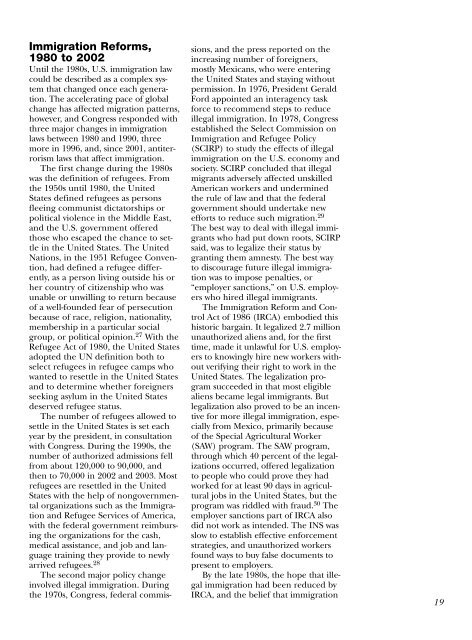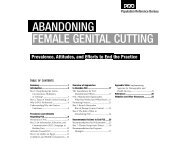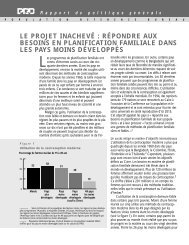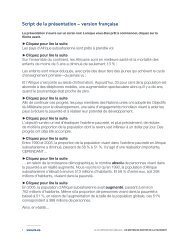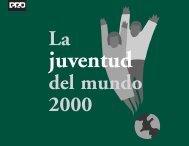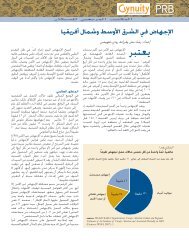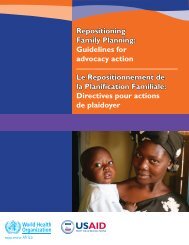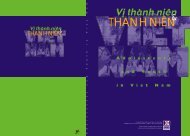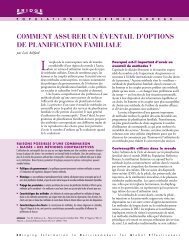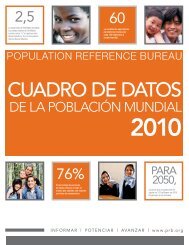Immigration Shaping America - Population Reference Bureau
Immigration Shaping America - Population Reference Bureau
Immigration Shaping America - Population Reference Bureau
Create successful ePaper yourself
Turn your PDF publications into a flip-book with our unique Google optimized e-Paper software.
<strong>Immigration</strong> Reforms,<br />
1980 to 2002<br />
Until the 1980s, U.S. immigration law<br />
could be described as a complex system<br />
that changed once each generation.<br />
The accelerating pace of global<br />
change has affected migration patterns,<br />
however, and Congress responded with<br />
three major changes in immigration<br />
laws between 1980 and 1990, three<br />
more in 1996, and, since 2001, antiterrorism<br />
laws that affect immigration.<br />
The first change during the 1980s<br />
was the definition of refugees. From<br />
the 1950s until 1980, the United<br />
States defined refugees as persons<br />
fleeing communist dictatorships or<br />
political violence in the Middle East,<br />
and the U.S. government offered<br />
those who escaped the chance to settle<br />
in the United States. The United<br />
Nations, in the 1951 Refugee Convention,<br />
had defined a refugee differently,<br />
as a person living outside his or<br />
her country of citizenship who was<br />
unable or unwilling to return because<br />
of a well-founded fear of persecution<br />
because of race, religion, nationality,<br />
membership in a particular social<br />
group, or political opinion. 27 With the<br />
Refugee Act of 1980, the United States<br />
adopted the UN definition both to<br />
select refugees in refugee camps who<br />
wanted to resettle in the United States<br />
and to determine whether foreigners<br />
seeking asylum in the United States<br />
deserved refugee status.<br />
The number of refugees allowed to<br />
settle in the United States is set each<br />
year by the president, in consultation<br />
with Congress. During the 1990s, the<br />
number of authorized admissions fell<br />
from about 120,000 to 90,000, and<br />
then to 70,000 in 2002 and 2003. Most<br />
refugees are resettled in the United<br />
States with the help of nongovernmental<br />
organizations such as the <strong>Immigration</strong><br />
and Refugee Services of <strong>America</strong>,<br />
with the federal government reimbursing<br />
the organizations for the cash,<br />
medical assistance, and job and language<br />
training they provide to newly<br />
arrived refugees. 28<br />
The second major policy change<br />
involved illegal immigration. During<br />
the 1970s, Congress, federal commissions,<br />
and the press reported on the<br />
increasing number of foreigners,<br />
mostly Mexicans, who were entering<br />
the United States and staying without<br />
permission. In 1976, President Gerald<br />
Ford appointed an interagency task<br />
force to recommend steps to reduce<br />
illegal immigration. In 1978, Congress<br />
established the Select Commission on<br />
<strong>Immigration</strong> and Refugee Policy<br />
(SCIRP) to study the effects of illegal<br />
immigration on the U.S. economy and<br />
society. SCIRP concluded that illegal<br />
migrants adversely affected unskilled<br />
<strong>America</strong>n workers and undermined<br />
the rule of law and that the federal<br />
government should undertake new<br />
efforts to reduce such migration. 29<br />
The best way to deal with illegal immigrants<br />
who had put down roots, SCIRP<br />
said, was to legalize their status by<br />
granting them amnesty. The best way<br />
to discourage future illegal immigration<br />
was to impose penalties, or<br />
“employer sanctions,” on U.S. employers<br />
who hired illegal immigrants.<br />
The <strong>Immigration</strong> Reform and Control<br />
Act of 1986 (IRCA) embodied this<br />
historic bargain. It legalized 2.7 million<br />
unauthorized aliens and, for the first<br />
time, made it unlawful for U.S. employers<br />
to knowingly hire new workers without<br />
verifying their right to work in the<br />
United States. The legalization program<br />
succeeded in that most eligible<br />
aliens became legal immigrants. But<br />
legalization also proved to be an incentive<br />
for more illegal immigration, especially<br />
from Mexico, primarily because<br />
of the Special Agricultural Worker<br />
(SAW) program. The SAW program,<br />
through which 40 percent of the legalizations<br />
occurred, offered legalization<br />
to people who could prove they had<br />
worked for at least 90 days in agricultural<br />
jobs in the United States, but the<br />
program was riddled with fraud. 30 The<br />
employer sanctions part of IRCA also<br />
did not work as intended. The INS was<br />
slow to establish effective enforcement<br />
strategies, and unauthorized workers<br />
found ways to buy false documents to<br />
present to employers.<br />
By the late 1980s, the hope that illegal<br />
immigration had been reduced by<br />
IRCA, and the belief that immigration<br />
19


